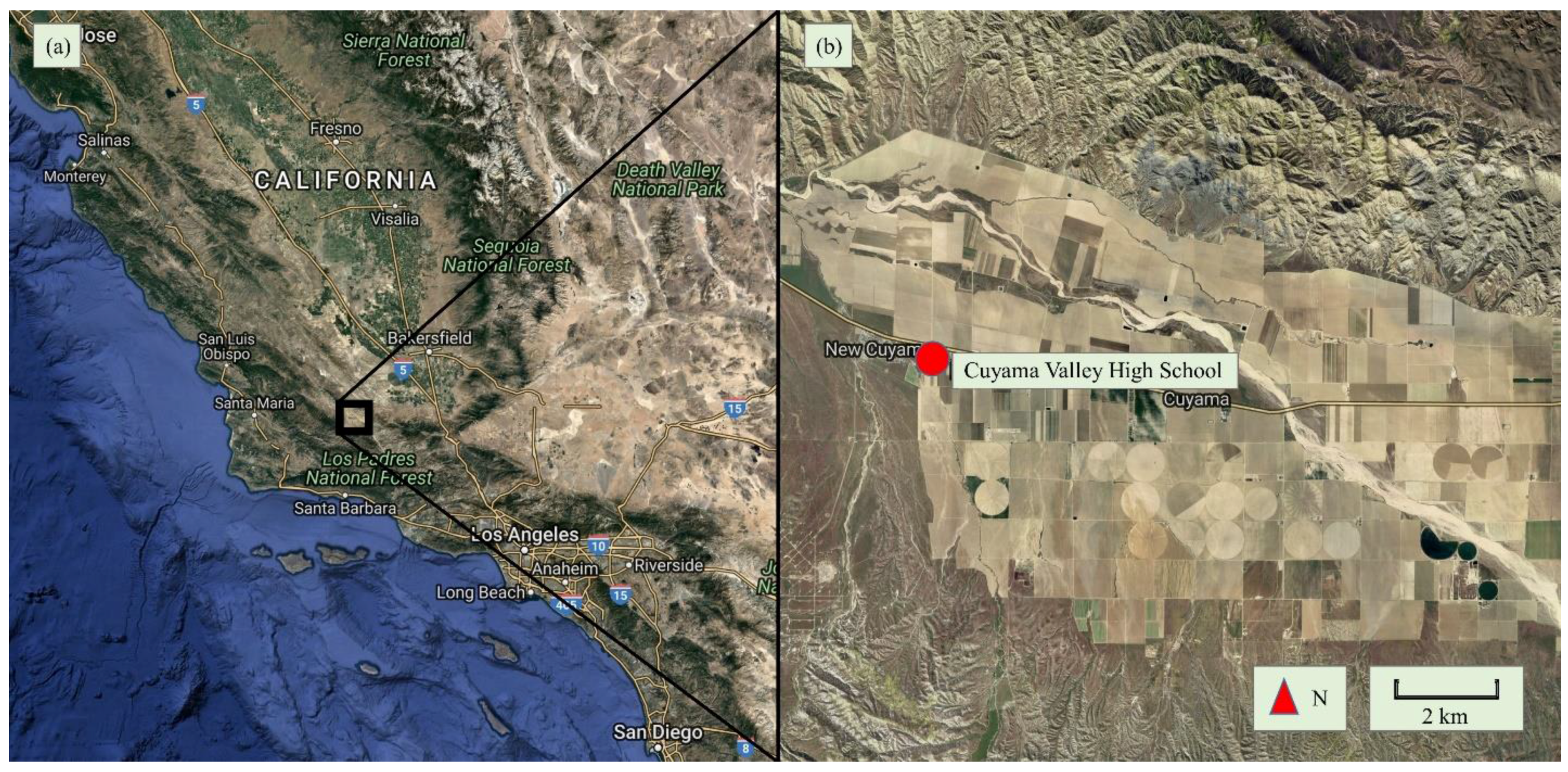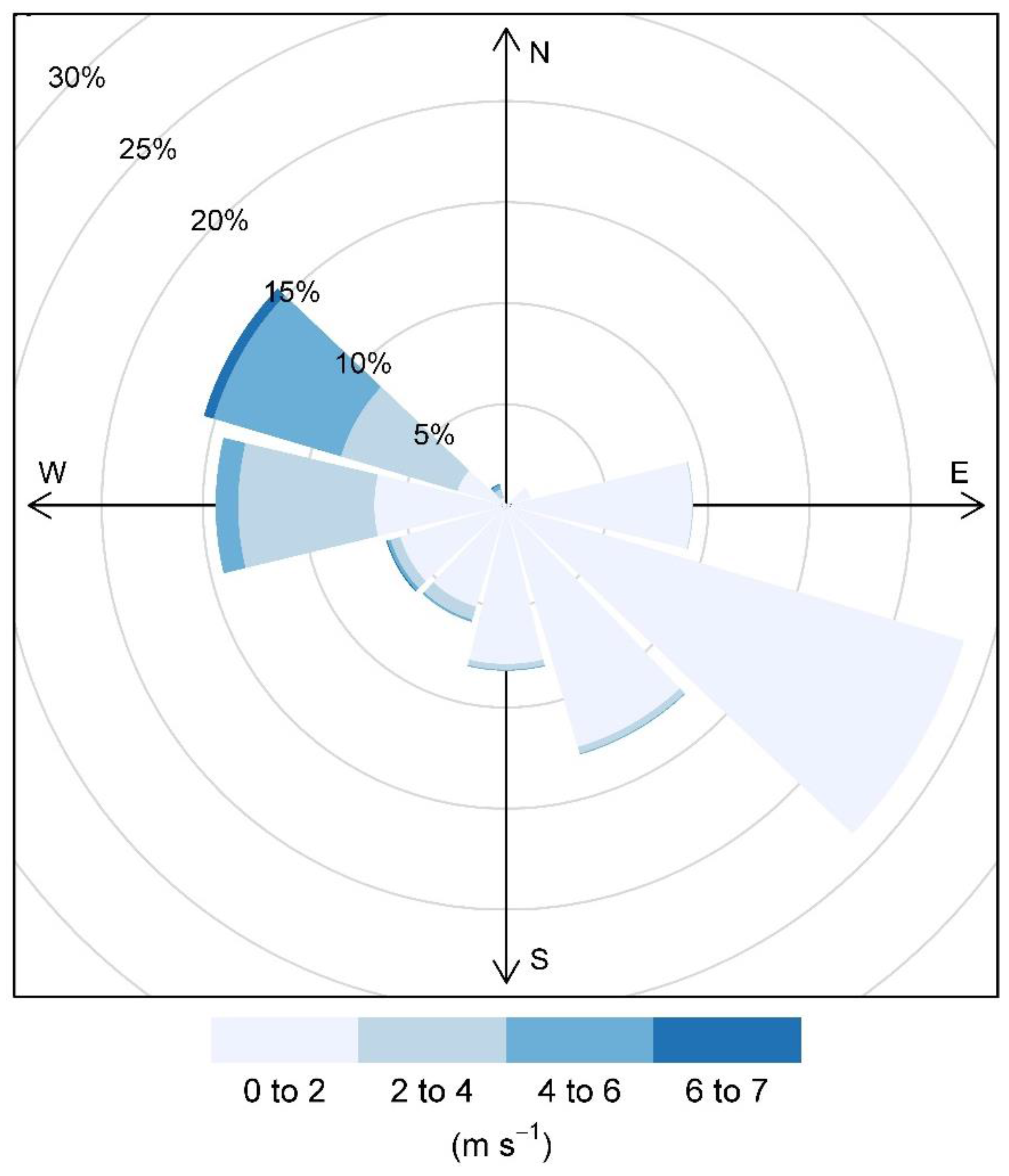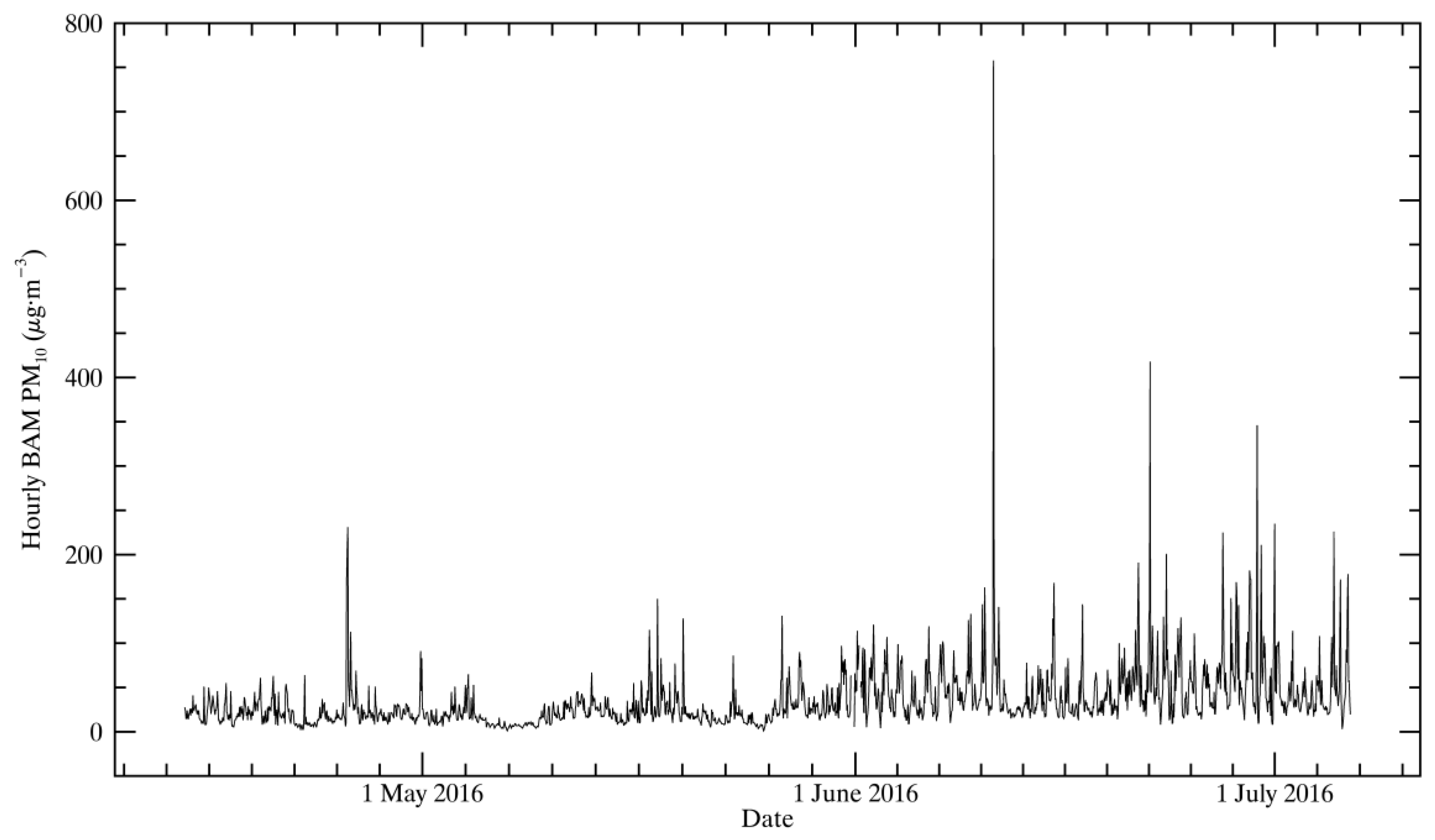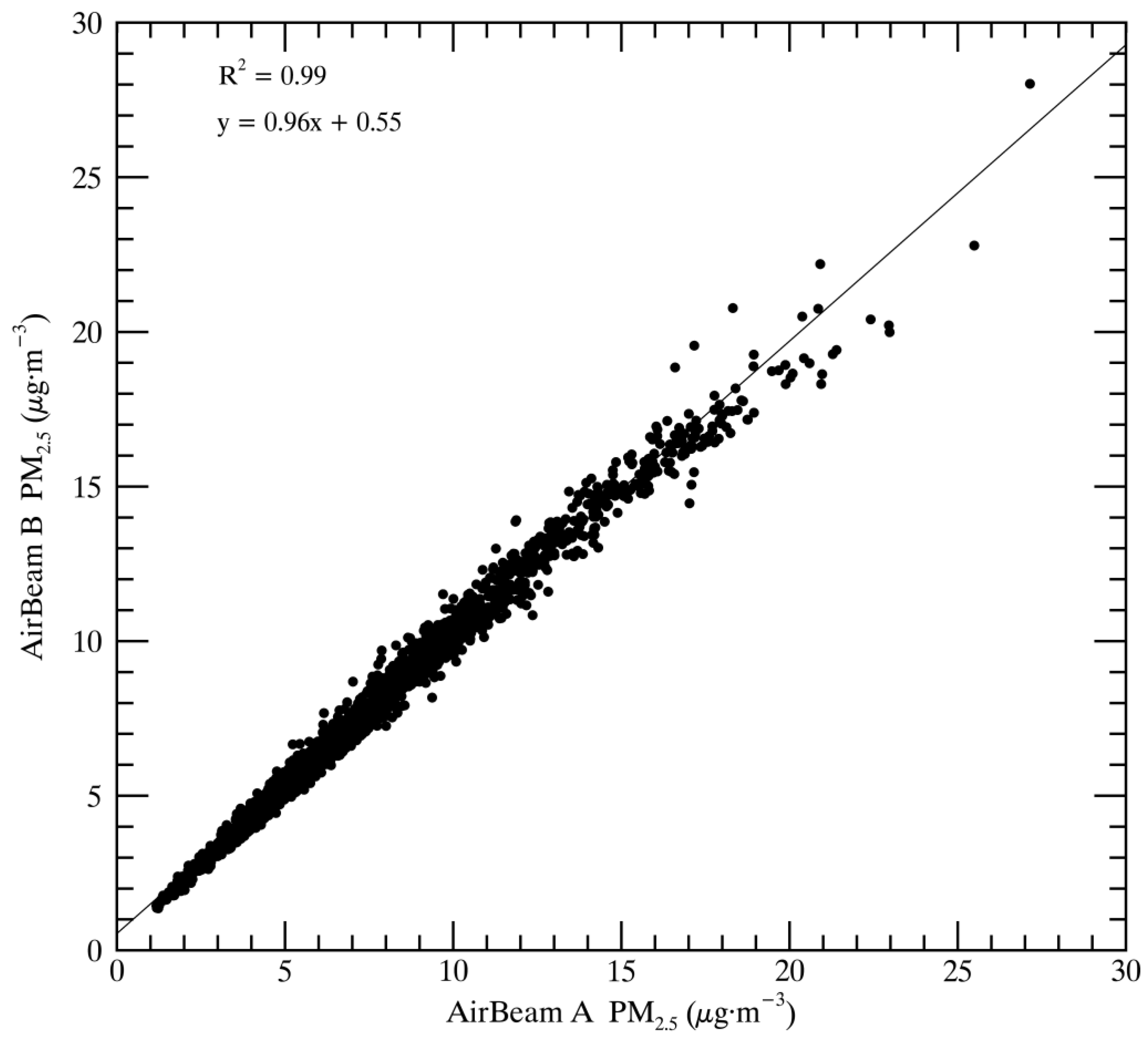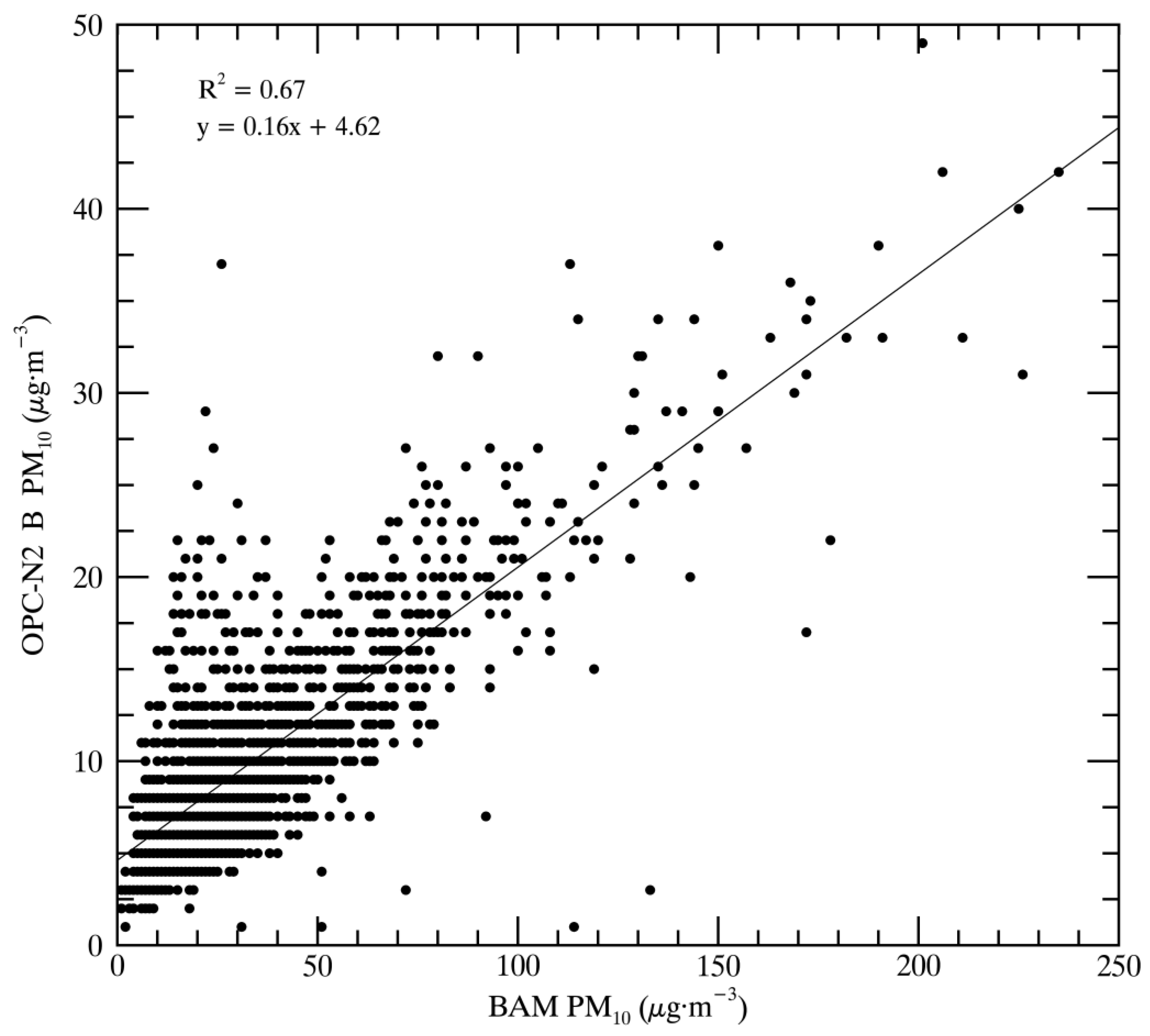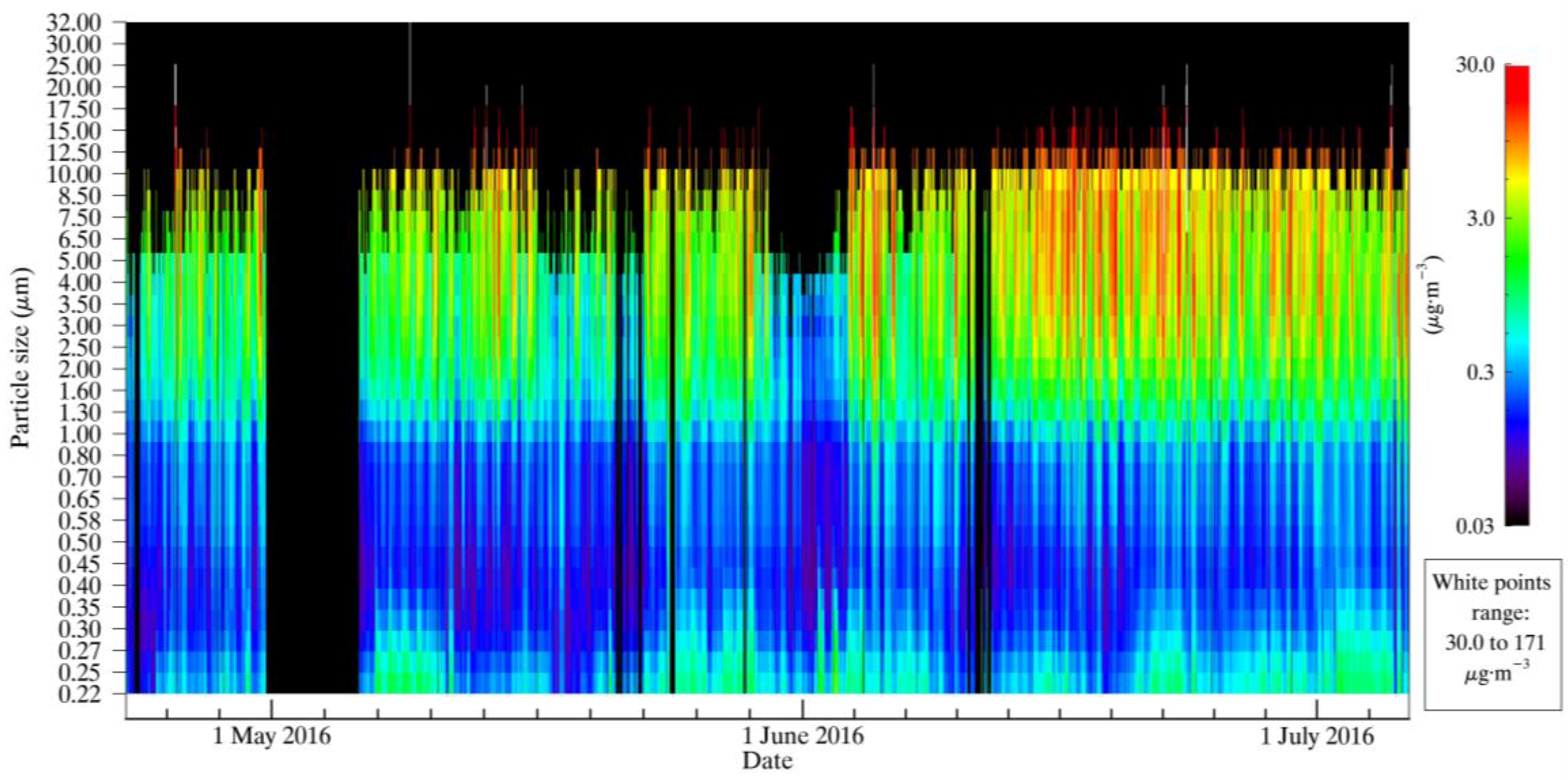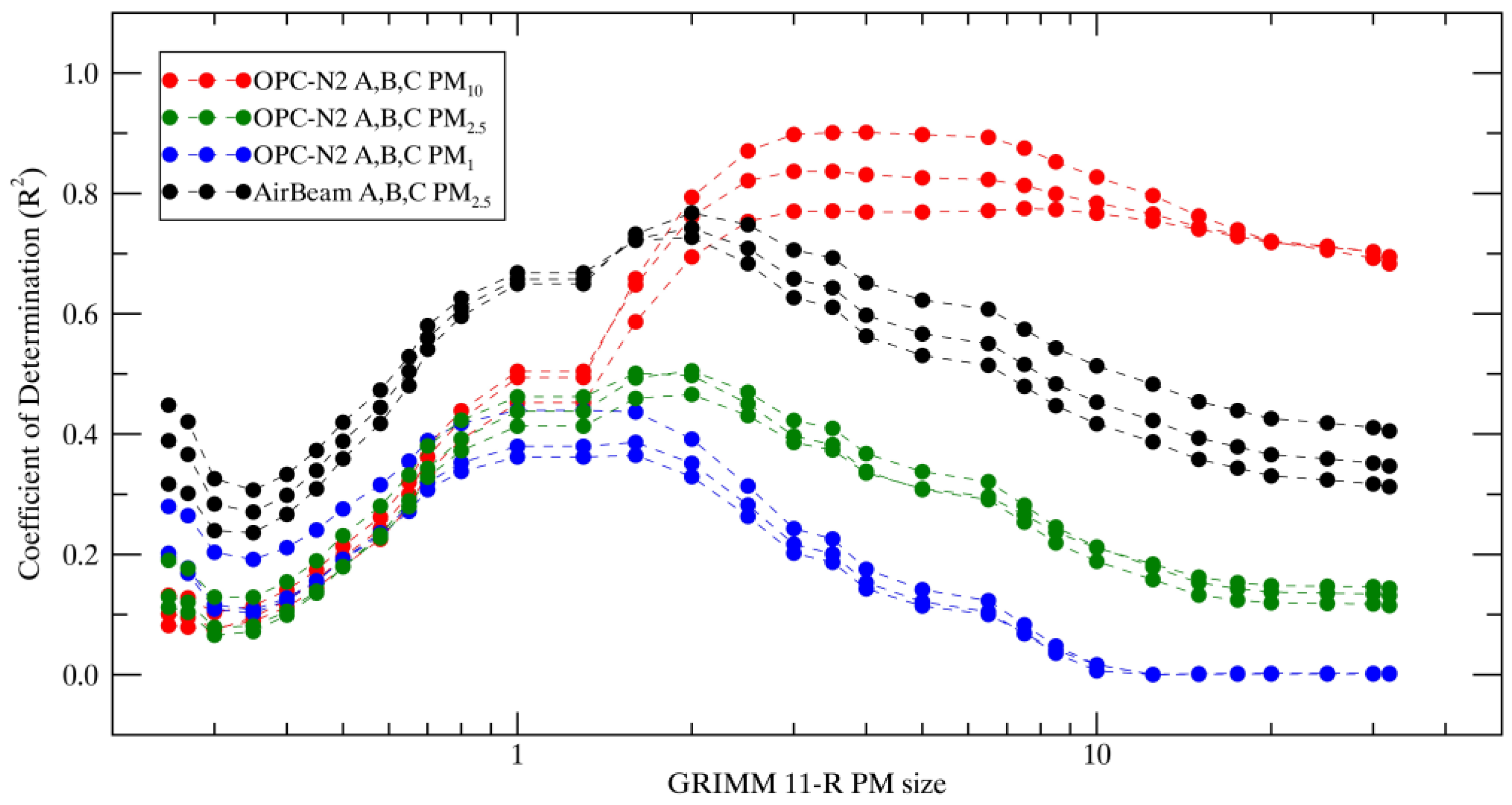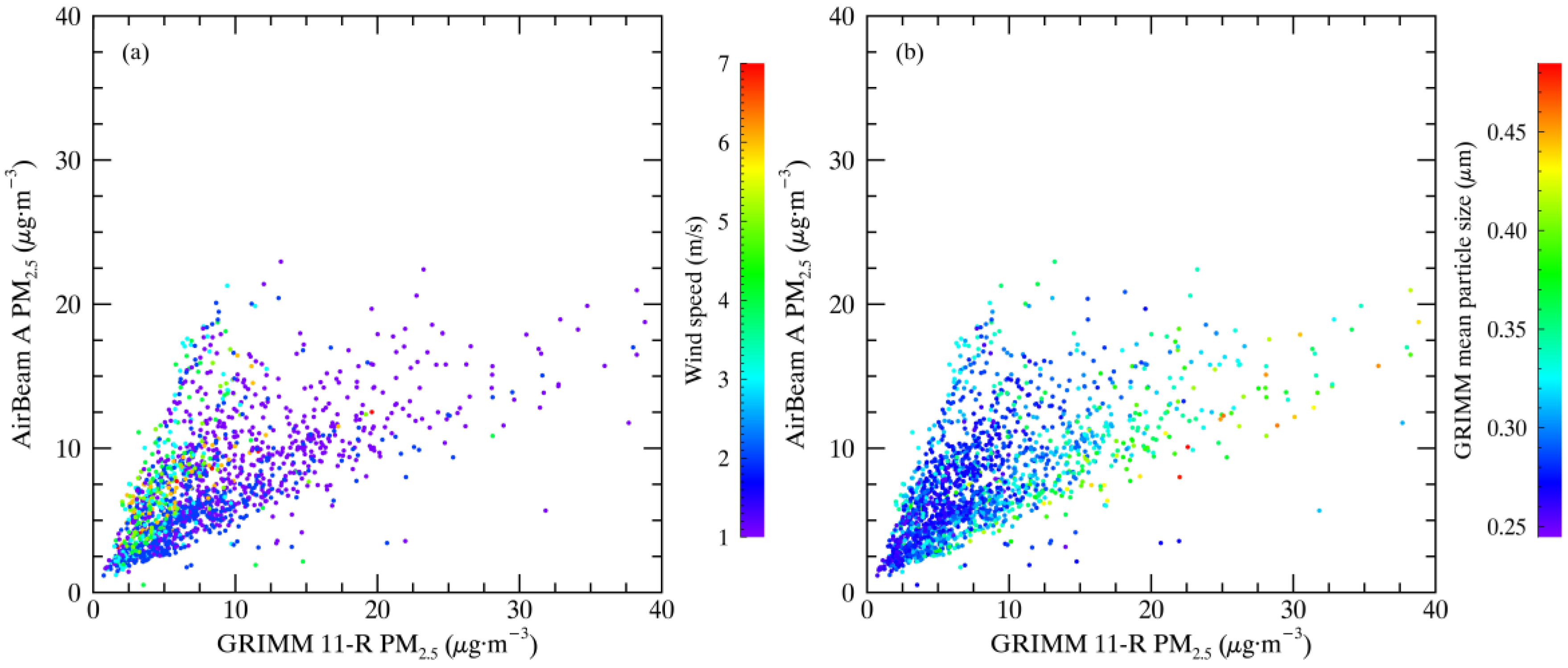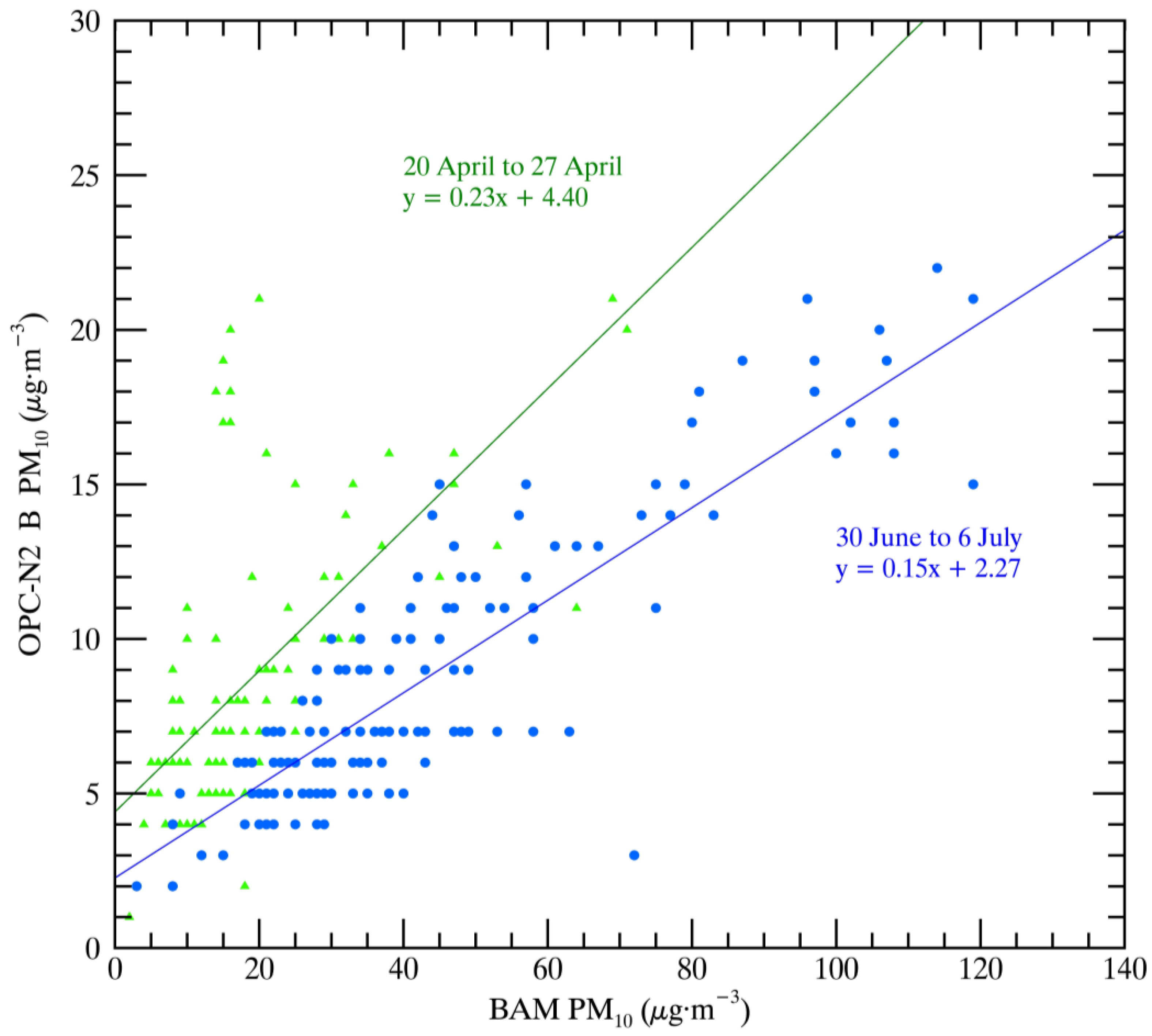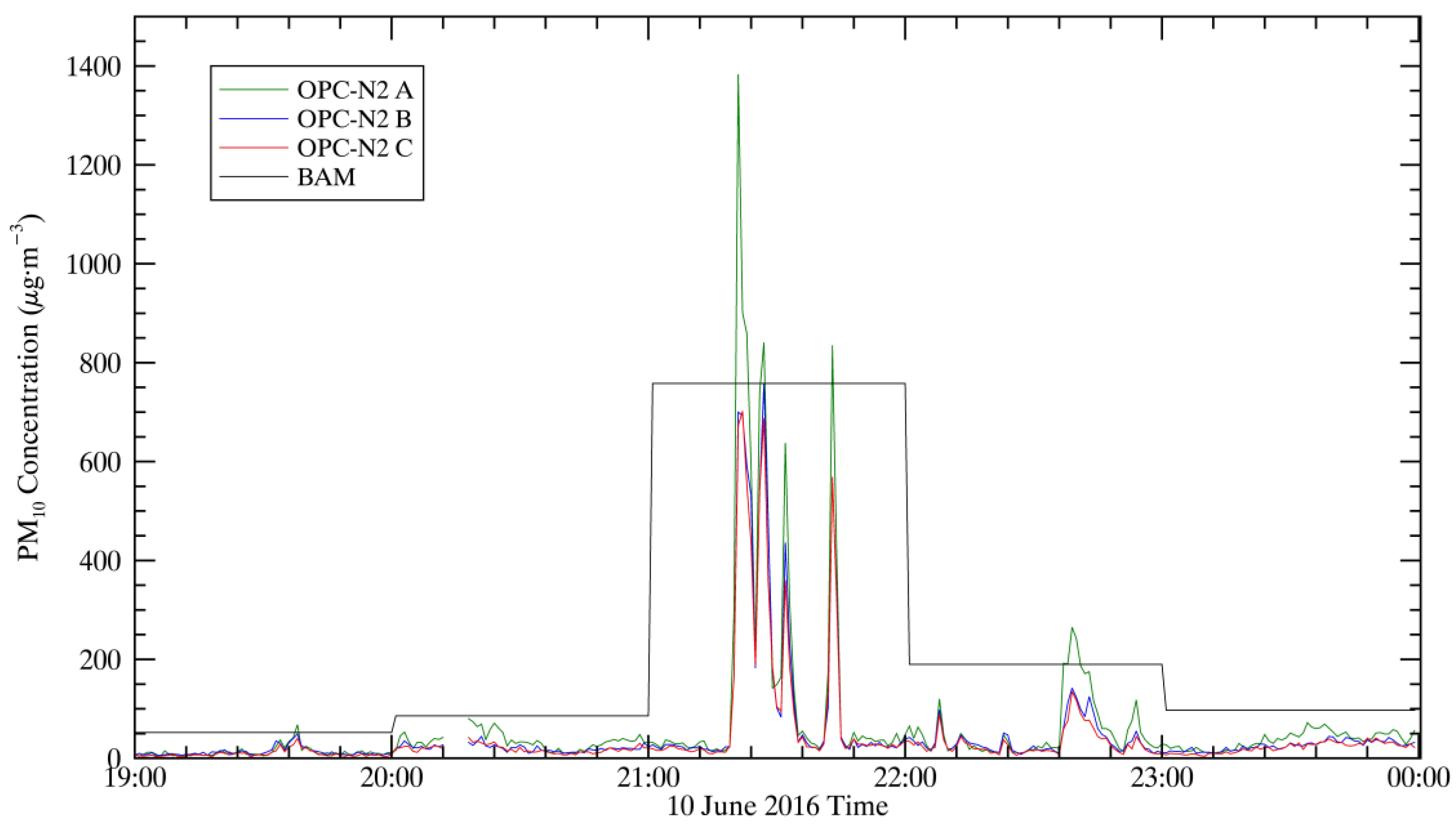1. Introduction
Air pollution poses a significant global health risk in both developing nations and advanced economies. In a recent epidemiology study, Lelieveld et al. [
1] estimated that outdoor air pollution contributed to over 3 million premature deaths in 2010 through cardiovascular and respiratory illnesses, with a majority of deaths occurring in Asia. A recent World Health Organization (WHO) study found that 92% of the world’s population lives in environments where particulate matter (PM) concentrations exceed WHO-recommended levels [
2].
In the United States, the Environmental Protection Agency (EPA) regulates the ambient concentrations of various air pollutants, including PM (expressed in µg∙m
−3). The impacts of PM on human health depend on particle size, because fine particles can travel deeper through the respiratory system than larger particles [
3]. The health risk of PM is also dependent on the chemical composition of the particles and their toxicology [
3]. Size ranges of interest for PM include PM of ~1 µm and smaller in aerodynamic diameter (PM
1, also called submicron particles), PM of 2.5 µm and smaller in aerodynamic diameter (PM
2.5, also called fine particles), and PM of 10 µm and smaller in aerodynamic diameter (PM
10), which have become useful standards for measurements of air quality in the United States and globally. PM
10 and PM
2.5 are criteria pollutants for which EPA has established national ambient air quality standards (NAAQS) to regulate concentrations and minimize health impacts. The 24 h NAAQS for PM
10 and PM
2.5 are currently 150 µg m
−3 and 35 µg m
−3, respectively [
4]. In order to ensure these standards are met, instruments that collect data for regulatory purposes must be certified as meeting rigorous quality standards. The EPA designates instruments that have met these standards as federal reference methods or federal equivalent methods (FRM, FEM). The beta attenuation monitor (BAM-1020, Met One Instruments Inc., Grant Pass, OR, USA) has been certified as an EPA FEM instrument for PM
2.5 and PM
10, provided it is installed, operated, and calibrated according to established procedures.
Air pollution has become a major concern for the public, as air pollution has received increased media attention, and local and national governments continue to publicize their efforts to improve air quality. Governments and other organizations are also broadcasting air quality data in real time, which has increased public awareness.
The interest and demand for air quality data has led companies to develop low-cost portable air quality sensors. Some of these sensors are marketed directly to consumers who are interested in their personal exposure. The sensors also have a wide range of potential applications, depending on the quality of the measurements. Because the regulatory monitoring network maintained by the EPA is sparse, with a limited spatial density, low-cost sensors have the potential to provide insight into the spatial and temporal variability of pollutants; data from these sensors could inform studies of personal exposure and emission inventories if the quality of the measurement is robust enough to meet the given objectives [
5,
6]. Air quality researchers are also examining the deployment of sensor networks and the potential value of integrating these sensors into the existing air quality regulatory network [
7,
8]. However, different interpretations of data require different levels of confidence in data quality.
The proliferation of measurements from low-cost air sensors presents data interpretation challenges, as few studies have examined the performance (i.e., accuracy, precision, and reliability) of the sensors under real-world conditions [
6]. Quantifying the performance of low-cost air quality sensors is an active area of research, as studies examine sensor measurements in a variety of real-world environments and controlled conditions [
9,
10,
11]. Studies have also examined the performance of a network of sensors, and the use of those measurements to quantify pollution hot spots [
12,
13]. The validity and uncertainty of sensor measurements over a range of different meteorological and aerosol loading environments needs to be quantified. The need to validate sensor measurements against established methods in real-world environments is key, as laboratory experiments do not typically reflect the variability of meteorological and pollution conditions found in the real world [
11,
14]. This is a requisite step to ensuring that sensors can be deployed for objectives appropriate to confidence in data quality.
Santa Barbara County Air Pollution Control District (SBCAPCD) entered into contract with Sonoma Technology, Inc. (STI) to investigate the use of low-cost sensors for monitoring dust by conducting a pilot field study at Cuyama Valley High School in New Cuyama, California. This study evaluated the performance of two low-cost portable PM sensor models: the Optical Particle Counter, OPC-N2 (available for ~450 USD, Alphasense Ltd., Essex, UK) and the AirBeam (available for ~250 USD, HabitatMap Inc., Brooklyn, New York, NY, USA), for detecting particulate matter in the Cuyama Valley of California. Cuyama Valley is a sparsely populated area in southern California, with significant agriculture in the regions of the valley where the topography is flat.
Figure 1 shows the general area of the Cuyama Valley and the location of the monitoring site at Cuyama Valley High School in relation to nearby agricultural areas. Major sources of particulate matter include wind-blown dust and regional transport. To examine regional transport patterns, STI modeled transport trajectories for several of the high PM
10 concentration days identified during this study using the hybrid single-particle Lagrangian integrated trajectory (HYSPLIT) model. Modeled regional transport patterns suggest that, on some days, PM
10 from the California Central Valley is transported to the New Cuyama area, contributing to the concentrations observed. However, the short-duration high-concentration events reported by the sensors suggest that local transport of dust is also a major contributor to the observed higher PM
10 concentrations.
The objectives of the study were to determine whether the low-cost PM sensors detect dust events and if so, how well they detect dust events; to determine how precise the sensor measurements are, and whether sensor precision is sufficient either for use in a network to monitor the spatial variability of PM, or to obtain localized data to augment information available from the regional monitoring network; to determine whether the sensors operate continuously and meet data completeness requirements for reliably detecting dust events; and to determine whether the sensors could be used as part of an “early warning system” to inform decisions to reduce exposure to high PM concentrations.
Precision was examined by comparing data from three sensors of the same model. Accuracy was examined by comparing sensor measurements with the FEM BAM, and with the GRIMM 11-R optical particle counter (GRIMM Aerosol Technik GmbH & Co., Ainring, Germany). The impact of meteorology and the variations of the size distribution were also examined. The potential use of these sensors to inform behavior is presented, such as using high temporal resolution to limit exposure.
2. Methodology
STI (Petaluma, CA, USA) deployed six low-cost PM sensor devices and conducted a three-month field study from 14 April 2016, to 6 July 2016, to characterize the performance of the sensors for detecting PM events in the Cuyama Valley environment. Three OPC-N2 and three AirBeam sensors were deployed at Cuyama Valley High School to evaluate sensor performance over a range of conditions. The sensors were collocated with a BAM-1020 measuring PM10, a GRIMM 11-R measuring particle sizes, and an R.M. Young 05305V meteorological station measuring wind speed and direction at 1 min temporal resolution. The BAM-1020 was deployed to evaluate the accuracy of the OPC-N2 PM10 measurements. Three of each of the two low-cost sensor models were deployed to assess sensor precision and reliability. The GRIMM 11-R was deployed to obtain particle size information and assist with interpretation of sensor performance as a function of particle size. GRIMM 11-R measurements of the particle size distribution were converted to particle mass distribution, including PM1, PM2.5, and PM10.
All of the instruments were collocated within a few feet of one another. Initially, three containers on a small tripod housed one OPC-N2 and one AirBeam sensor each. Each container was equipped with a vent to allow air to be drawn in and a small exhaust fan to blow air out. The meteorological equipment was located on a second tripod. The BAM and GRIMM 11-R were housed nearby in a climate-controlled shelter. Data collected during the study were stored onsite and transmitted in real time to STI’s servers via a cellular modem for archival within a data management system developed for the project. To assess the impacts from sampling orientation on sensor measurements, the sampling orientation for the sensors was varied as shown in
Table 1. The reference instruments, BAM and GRIMM 11-R, were oriented with omnidirectional sampling. On 1 June 2016, OPC-N2 A was relocated to a third tripod so that it could sample omni-directionally to assess the impacts of sampling orientation.
Both the AirBeam and the OPC-N2 are optical particle counters (OPCs). An OPC measures the scattered light from a sampled stream of aerosol particles to reconstruct particulate mass concentration [
15]. The AirBeam followed an open source development model, so the firmware and the electronic schematics for the instrument are available online. A light-emitting diode (LED) source of visible green light is used to detect particles, and the raw measurement provides particle counts for all particle sizes sampled. In this study, the default conversion algorithm was used to convert these counts (recorded in hundreds of particles per cubic feet, hppcf) to PM
2.5 mass concentration at a one-minute temporal resolution, which includes assumptions about the particle mass density, refractive index of the particle, and the size distribution. This conversion factor is PM
2.5 (µg∙m
−3) = 0.518 + 0.00274 × particle count (hppcf). The AirBeam sensor system also measures temperature and relative humidity [
16].
The OPC-N2 uses a laser beam at 658 nm as the light source. The resulting scattered light is focused using an elliptical mirror toward a dual-element photodetector. The firmware of the OPC-N2 is considered proprietary information and includes default settings of 1.5 + 0i for the refractive index of particles and 1.65 g∙cm
−3 for particle mass density. The refractive index assumption is required because both the intensity and angular distribution of scattered light from the particle are dependent upon it. The OPC-N2 detects particles with diameters within the range of 0.38 µm to 17 µm. Each particle count is classified into one of 16 size bins within this range, resulting in an approximation of the particle size distribution. The firmware calculates values of PM
1, PM
2.5, and PM
10 at a one-minute temporal resolution based on the particle size distribution using the assumed particle mass density value. The OPC-N2 is calibrated by the manufacturer using polystyrene spherical latex particles with a known diameter, refractive index, and density. No correction factor for particle density was applied to the data collected during this study. The assumed particle density of 1.65 g cm
−3 may be a source of uncertainty for different chemical compositions of PM [
17].
PM concentrations were also derived from a GRIMM 11-R OPC. The GRIMM 11-R also measures the particle size distribution through the detection of scattered light. The GRIMM 11-R classifies particle counts into 31 size bins between 0.25 µm and 32 µm at a one-minute resolution. The GRIMM 11-R instrument was designed for the detection of dust particles, which are a major source of PM in the Cuyama Valley environment. Therefore, it is possible that the GRIMM 11-R makes more accurate assumptions of the particle refractive index and in the scattering response of particles than the OPC-N2 and the AirBeam. Concentrations of PM
1, PM
2.5, and PM
10 were computed by converting the particle size distributions into particle volume distributions, using the center of the size bin as the particle diameter for all counts within each respective bin. Then, the total particle volume was computed by summing over the desired size range. A particle density of 1 g∙cm
−3 was used to convert the measurements to PM concentration values [
18].
A BAM-1020 was deployed as a reference instrument to measure PM
10. The BAM-1020 is a designated EPA FEM for hourly PM
10 monitoring and is used for over 80% of PM
10 measurements in the United States at the federal, state, and local levels [
19]. Particles larger than 10 μm in diameter are removed by a cyclone, and air is then passed through a chamber that is heated to 20 °C before particles are impacted onto a filter tape that, after a period of collection, is exposed to a source of beta radiation [
20]. The degree of absorption of that radiation by particulate matter collected on the filter tape is a sensitive measure of particle mass that is quantified by careful calibration procedures [
20,
21].
Because the instruments use different techniques and have different assumptions in their retrieval of PM values, there are known biases in their measurements depending on the size distribution and chemical composition of the aerosol particles. Because the OPC sensors rely on the detection of scattered light, the measurement of aerosols that are highly absorptive would have a significant low bias. This would be important in environments where the emission of incomplete combustion products leads to a high mass fraction of black carbon in PM. A recent study quantified this impact, showing that OPC-N2-measured values of PM
2.5 and PM
10 were a factor of 10 lower for highly absorptive welding fume aerosols than for salt aerosols, compared to the reference measurements by a scanning mobility particle sizer (SMPS) and an aerodynamic particle scanner (APS) [
22]. This bias is not likely to be significant in an environment such as Cuyama Valley, where non-absorbing wind-blown dust is a major source of particulate matter. Another source of bias is the variability of the size distribution of the aerosols. Because the GRIMM 11-R has almost twice the size bin resolution as the OPC-N2, we can expect greater accuracy due to the variability in the size resolution. Further, the OPC-N2 would have greater accuracy than the AirBeam due to this bias, because the AirBeam converts particle counts to PM
2.5 from one size bin of measurements while assuming a predetermined particle size distribution. GRIMM 11-R measurements are used to quantify how the varying particle size distribution can impact sensor measurements of PM.
4. Conclusions
Having quantified the performance of the sensors, we present recommendations on the potential utility of the measurements and their deployment in an environment like Cuyama Valley. In Cuyama Valley, there are no air quality monitoring stations in the existing EPA infrastructure; the nearest monitor is in Maricopa, approximately 20 km to the northeast. Cuyama Valley is a unique environment surrounded by mountains, and local air quality measurements could provide valuable information where none exists. While the sensors reported significantly low measurements relative to the GRIMM 11-R and BAM (
Table 3 and
Table 4), by a factor of 2–4, they could still be utilized as a qualitative measure of high PM events. All sensors and instruments showed coherence in reporting short-term PM events. Furthermore, if the sensors were routinely calibrated relative to a reference monitor, the corrected measurements would be more quantitative, although this calibration may need to be carried out periodically to compensate for the possible influence of drift.
The low-cost sensors demonstrate a robust quality of performance by certain measures, such as high precision and reliability. The OPC-N2 and the AirBeam showed high precision over a range of conditions. The high precision of the sensors (for each sensor model and PM variable) implies that a set of sensors can be utilized to give a consistent, intercomparable measurement which is necessary for being deployed as a network. Sampling orientation was demonstrated to influence the accuracy of the measurements, which has implications for their use as personal sensors or instruments to be integrated into networks. Omnidirectional sampling would improve the consistency of PM measurements.
The accuracy of the OPC-N2 is limited by its drift, which may be due to dust impacting the sampling flow rate. In spite of this drawback, the OPC-N2 demonstrates reasonable correlation against the FEM standard BAM. The low fraction of PM10 measured by the OPC-N2 relative to the BAM and GRIMM 11-R is likely due to a combination of drift, sampling of the size distribution, or an internal calibration to a different particle chemical composition/size distribution. The AirBeams demonstrated a higher degree of accuracy for measuring PM2.5 compared to GRIMM 11-R-derived PM2.5 (compared to the OPC-N2) in the Cuyama Valley environment.
The one-minute time resolution of the sensors relative to the FEM monitors is an advantage. This could be used as an early warning detection system of PM events in Cuyama and in urban environments. This is a unique benefit in the environment of Cuyama Valley, where some high PM events are of very short duration, whereas the BAM reports hourly PM measurements, using the first 52 min of sampling.
The sensors have demonstrated that they are useful for the assessment of short-term changes in the aerosol environment. Further examination of these emerging technologies is necessary, and sensors may be most useful as a supplement to the existing regulatory network. Incorporating collocation with established instruments in the field is encouraged for future studies.
